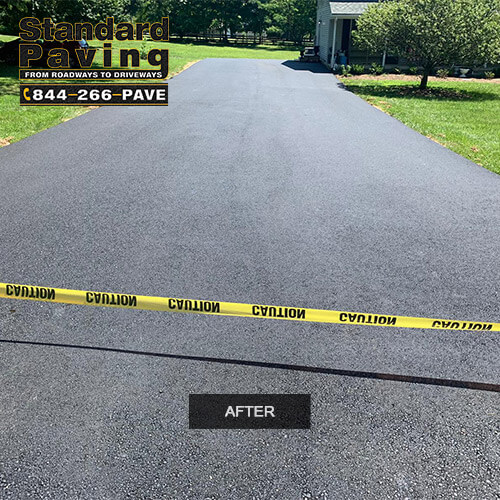Northern Virginia gets its fair share of rain. Loudoun and Fairfax counties average 43” per year compared to a national average of 37”. If your asphalt driveway sprouts mini lily ponds or small lakes after a heavy rain, you have a condition that will inevitably lead to your asphalt failing requiring a replacement drive to be installed.
Puddles in your driveway are more than just an annoyance. They are a sign that for whatever reason, your asphalt driveway is not draining properly and that can lead to serious problems. New asphalt is waterproof. Asphalt products are often used by roofing companies to seal around flashing and roof joints. In theory, rainwater, or even flood water, should drain right off of an asphalt drive. When it doesn’t and the asphalt is exposed to sustained contact with water, it can partially breakdown creating cracks. Which in turn can lead to larger cracks and even a need to replace the drive.
The obvious solution, is to determine why the water is pooling, fix it, and eliminate the cause.
Causes of Standing Water on Asphalt Driveways
 With the infrequent exception of ruts formed by heavy vehicles parked in the same place over an extended time, low spots on asphalt drives are caused by a settling of the substrate under the drive. When your drive was installed, the ground beneath it was graded on a slope and then filled with 6” to 9” of gravel and other aggregate. That fill was then compacted with a vibrating roller to minimize settling and form a solid base on which the asphalt could be installed.
With the infrequent exception of ruts formed by heavy vehicles parked in the same place over an extended time, low spots on asphalt drives are caused by a settling of the substrate under the drive. When your drive was installed, the ground beneath it was graded on a slope and then filled with 6” to 9” of gravel and other aggregate. That fill was then compacted with a vibrating roller to minimize settling and form a solid base on which the asphalt could be installed.
Asphalt is a comparatively flexible paving material and can better handle earth movements caused by freezes and thaws than concrete. It can accommodate the contractions, expansions, and heaving caused by nature. But the substate is made of compressed gravel. It is more likely to be affected by earth movements and can “settle” creating a low space in the base which in turn will cause a low spot on the drive.
Another threat to the substrate is water. Water that finds its way into the substrate through cracks in the asphalt or a drainage problem, can wash away some of the aggregate and create voids. At some point the voids will collapse under the drive’s weight causing another low spot.
Natural drainage that channels water to or across the drive (and substrate) can also be a problem. Landscaping sometimes changes creating new natural drainage channels. Left unattended, poor drainage can literally wash away the substrate and collapse your asphalt drive.
The Fix
At Standard Paving we can “level up” low spots but if the cause of the low points is not addressed, our repairs will be temporary. Our process starts with an experienced estimator examining your drive and chatting with you about the standing water problem. Some drainage problems are easy to spot, others can take a little digging (literally) to uncover.
Typically, if a drive has a serious standing water problem, it will also have a bunch of cracks. If the substrate can be salvaged, we’ll start by identifying and removing failed asphalt in the the low spots, filling the holes, filling the cracks, resolving any drainage issues, power cleaning the drive, and then installing a new layer of asphalt over the existing drive. The end result is a cost effective new, slate black asphalt drive with no cracks, low spots, or drainage problems.
If you have your own personal lake after every rain, call the professionals at Standard Paving and we will be happy to send an estimator to check out your drive. Call us today and experience the professional difference Standard Paving provides!
